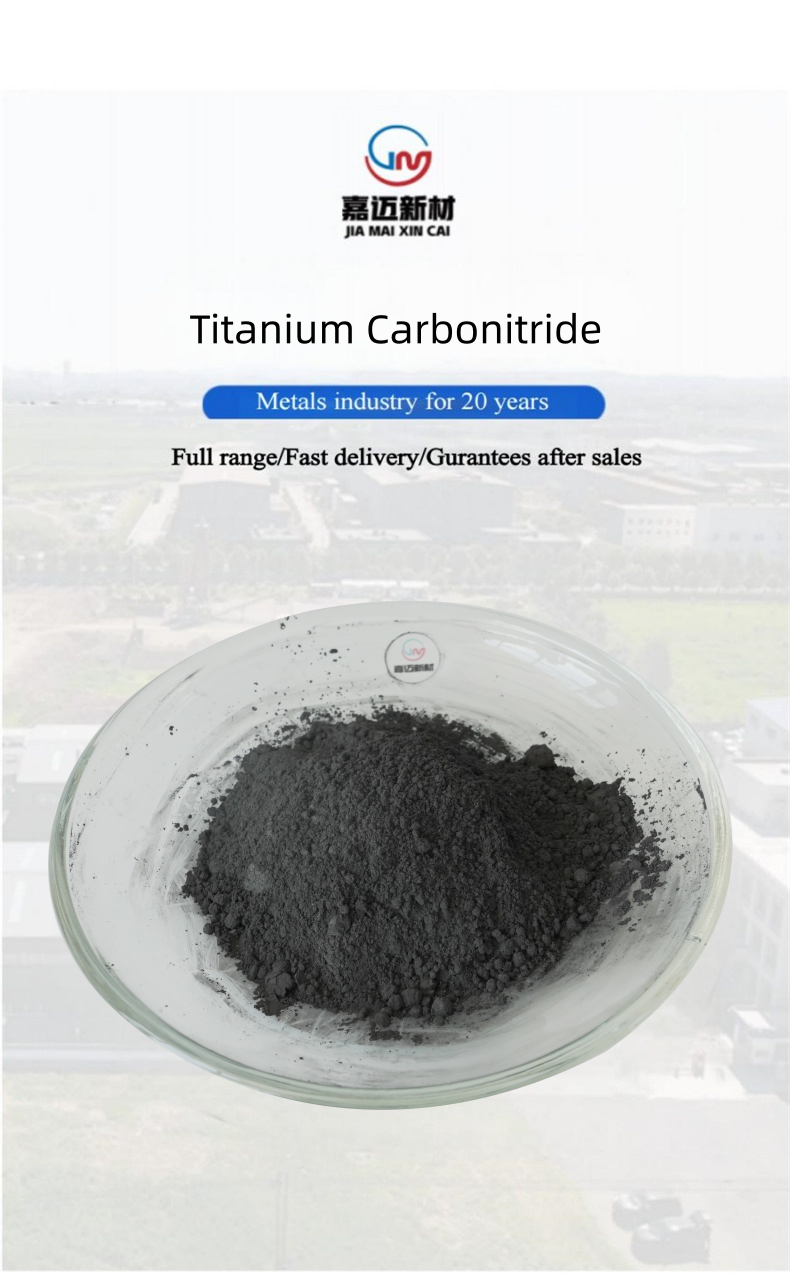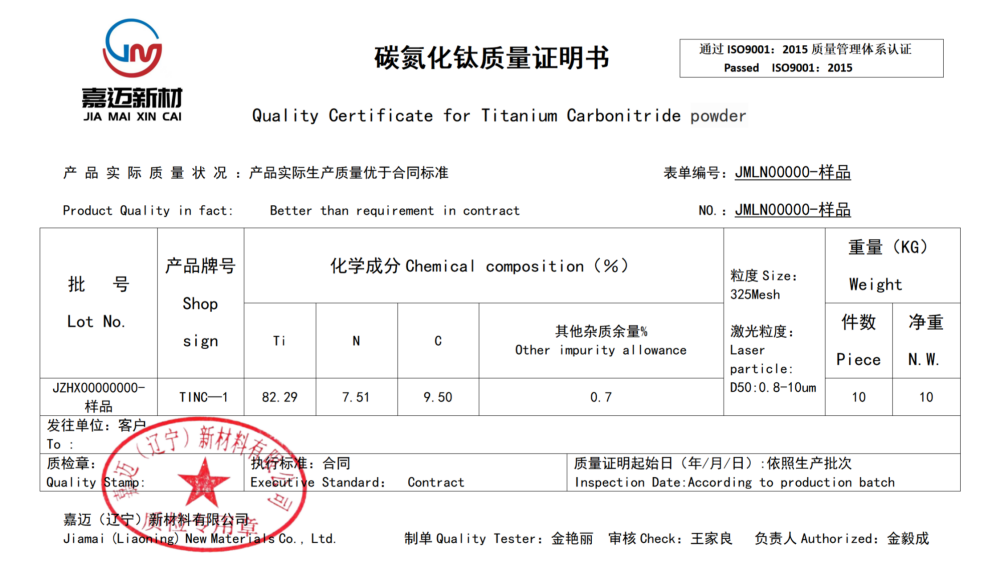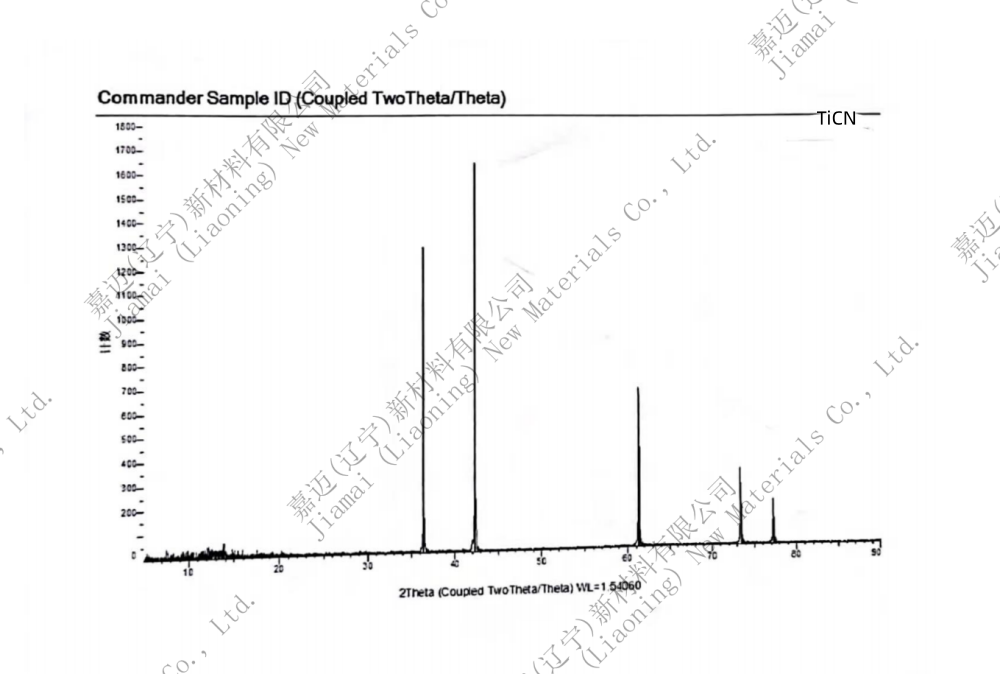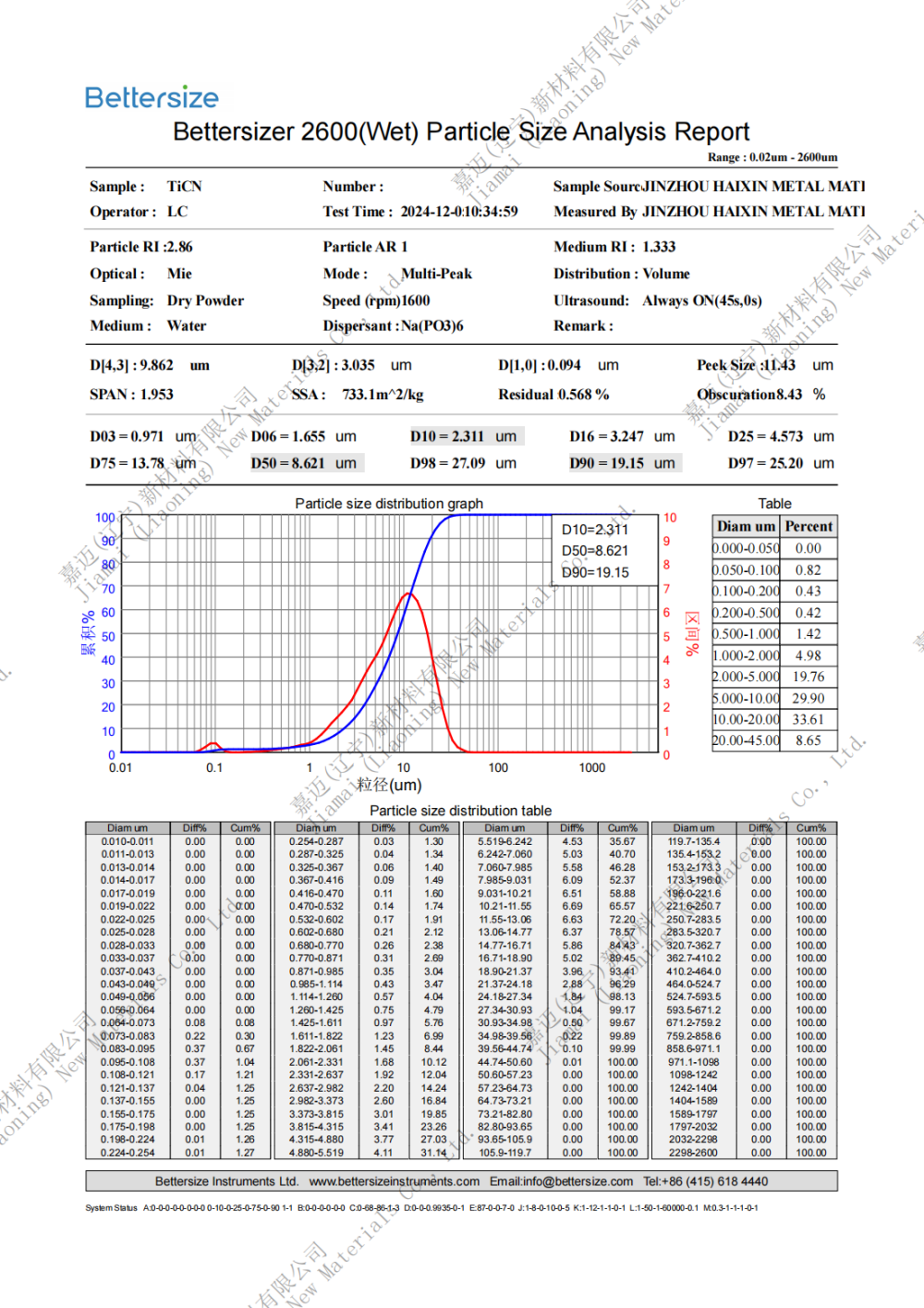
Product Name: Titanium Carbonitride (TiCN)
Specification: 0.8-10um (D50)
Appearance: Irregular
Color: Black Grey
Features: low friction coefficient, high hardness, high strength, good wear resistance, high temperature stability, and corrosion resistance
Application: Aerospace, automotive manufacturing, cutting tools and other fields







English name: Titanium Carbonitride
CAS: 12654-86-3
MDL: MFCD01868685
Molecular formula: TiCN
Molecular weight: 121.75
Melting point: 2900 ℃
Density: 5.08 g/mL at 25 ° C (lit.)
Hardness (HV): 34GPaI density is 4.52
Properties: A gray or gray black powder with a hexagonal crystal structure, low internal stress, high toughness, good lubricity, as well as high hardness and wear resistance. It is suitable for applications that require low friction coefficients and high hardness.
Technical performance:
1. Metal ceramics made of titanium nitride have the following characteristics: a hardness (HRA) of 91-95, which can reach the hardness level of non-metallic ceramic cutting tools; It has good wear resistance and ideal resistance to crescent wear, with extremely low wear rate during high-speed cutting of steel materials. Its wear resistance is 3-4 times higher than WC based hard alloys; It has high heat resistance, good high-temperature hardness, high-temperature strength, and high-temperature wear resistance. It can still be cut at high temperatures of 1100-1300 ℃, and the cutting speed is generally 2-3 times higher than WC based hard alloys; Has good chemical stability and high antioxidant capacity; Compared with hard alloys, titanium nitride metal ceramics have high wear resistance, lower oxidation degree, and better thermal shock resistance, making them suitable for use as high-speed cutting tool materials. They can effectively control the geometric accuracy and tolerance of workpieces, high smoothness, and high feed speed; Good results can be achieved when processing carbon steel, stainless steel, microalloyed steel, and ductile iron.
2. Titanium carbonitride is a glossy black powder and a zero dimensional ternary solid solution. TiC and TiN are the basis of titanium carbonitride and both have a face centered cubic lattice NaCl structure. They can also form solid solutions with various transition metal carbides such as TaC and NbC. Titanium carbonitride is a composite compound formed by nitrogen atoms (N) occupying the original position of carbon atoms (C) in a single TiC lattice. There are two ideal modes for the ratio of carbon and nitrogen atoms in TiCxNy, namely TiC0.5N0.5 and TiC0.3N0.7. Due to its comprehensive properties of TiC and TiN, TiCN has a higher hardness than TiC and TiN, making it an ideal tool coating material. Titanium carbonitride coating can improve the bonding strength with the substrate, while also possessing comprehensive properties of various materials.
Usage: 1) Wear resistant, acid and alkali resistant, strong electrical and thermal conductivity, low coefficient of thermal expansion, excellent chemical stability and heat resistance. Widely used in cutting tools, powder metallurgy, and metal ceramic products.
2) Coating: TiCN has a lower friction coefficient and higher hardness than TiN, and tools coated with titanium nitride are more suitable for cutting hard materials such as stainless steel, titanium alloys, and nickel alloys. It has better wear resistance and high temperature stability, which can significantly improve the tool life. Titanium nitride coating (TiN) is a universal PVD coating with a coating thickness of 2300HV. It is a mature and widely used hard coating material. Features: It has high hardness, high wear resistance, and oxidation resistance. Purpose: Suitable for most cutting tools and high-speed steel cutting tools or forming tools, improving their machining performance. It is also suitable for most forming molds and wear-resistant workpieces. Titanium carbide nitride coating (TiCN), in which carbon elements are added, can improve tool hardness and obtain better surface lubricity to reduce friction coefficient, making it an ideal coating for high-speed steel cutting tools. The thickness of the coating is 2800HV to prevent crack propagation and reduce chipping.
3) It combines the advantages of TiC and TiN. In addition to being very suitable for high-end precision machining and near net shape machining, it maintains the characteristics of TiC while significantly improving its brittleness due to the introduction of N. As the N content increases, its hardness decreases and toughness improves. It is precisely because of its excellent comprehensive performance that titanium nitride based ceramics have been widely used in cutting fields, high-temperature resistant materials, measuring tools, petroleum and chemical industries, clock appearance and other fields.
4) Adding non oxides to refractory materials can bring about some excellent properties. Studies have shown that the presence of titanium nitride can significantly improve the performance of refractory materials.
Preparation method:
1. High-temperature solid solution method
High temperature solid solution method is a traditional method for preparing Ti (C, N) powder, which is usually formed by uniformly mixing a certain amount of TiN and TiC powder and hot pressing solid solution at high temperature of 1700-1800 ℃, or by solid solution in Ar or N2 atmosphere at higher temperature. In order to suppress grain growth and improve powder activity and sintering performance, the solid solution temperature can also be appropriately reduced. Even if the solid solution temperature is lowered, the high-temperature solid solution method still has disadvantages such as high reaction temperature, high energy consumption, difficulty in obtaining high-purity powder, and inaccurate control of N/C ratio.
2. TiN and C powder high-temperature nitriding method
The high-temperature nitriding method usually uses TiN powder and C powder as raw materials, mixes them, and performs long-term carbonitride treatment under high temperature and N2 or Ar atmosphere to obtain Ti (C, N) powder. Frederic et al. synthesized Ti (C, N) powder by solid-phase synthesis using nano-sized TiN powder and 10wt% carbon black in Ar gas flow at 1430 ℃ for 3 hours, exhibiting regular shaped submicron particles. Similarly, the high-temperature nitriding method has disadvantages such as high reaction temperature, low production efficiency, high energy consumption, and high production costs.
3. High temperature self propagating reaction method
The high-temperature self propagating reaction method is to uniformly mix Ti powder and C powder, pre press them into a compact, and then ignite the reaction at high temperature in an N2 containing device to obtain bulk products. Ti (C, N) powder can be obtained by crushing and refining.
4. High energy ball milling induced self propagating synthesis method
High energy ball milling, as a powder processing method, can not only uniformly mix and activate powders to reduce sintering reaction temperature and promote alloying, but also induce self propagating reaction to synthesize nano Ti (C, N) powders at room temperature. The high-energy ball milling induced self propagating synthesis of Ti (C, N) technology integrates powder mixing and reaction, overcomes traditional high-temperature conditions, and can directly obtain Ti (C, N) powder.
5. TiO2 carbon thermal reduction nitridation method
The carbon thermal reduction nitridation method is a process of synthesizing Ti (C, N) powder by high-temperature reduction of TiO2 and C powder in N2. The size and morphology of the carbon thermal reduction product can be controlled by process parameters, and it is widely used in industrial large-scale production.
6. Ammonolysis method
The ammonolysis method usually involves dissolving TiCl4 in a suitable solvent and adding additives at room temperature. After mixing evenly, it reacts with NH3 to generate a homogeneous mixture of Ti amino compounds and additives as intermediates. Then, the intermediates are mixed with NH4Cl solution to precipitate and remove the amines in the intermediates. Finally, Ti (C, N) powder is obtained by pyrolysis at 1200-1600 ℃ under vacuum or Ar atmosphere. The characteristic of ammonolysis is that the preparation temperature is lower than traditional preparation methods (high-temperature solid solution method, 1800 ℃), and the obtained Ti (C, N) powder has the advantages of high specific surface area, small particle size, concentrated particle size distribution, and high purity. However, the cost is high and the process is complex.
Storage conditions:
Storage precautions: Store in a cool, dry, well ventilated dedicated warehouse with sealed packaging.
Preparation of titanium carbonitride powder
1. High temperature solid solution method
High temperature solid solution method is a traditional method for preparing Ti (C, N) powder, which is usually formed by uniformly mixing a certain amount of TiN and TiC powder and hot pressing solid solution at high temperature of 1700-1800 ℃, or by solid solution in Ar or N2 atmosphere at higher temperature. In order to suppress grain growth and improve powder activity and sintering performance, the solid solution temperature can also be appropriately reduced. Even if the solid solution temperature is lowered, the high-temperature solid solution method still has disadvantages such as high reaction temperature, high energy consumption, difficulty in obtaining high-purity powder, and inaccurate control of N/C ratio.
2TiN and C powder high-temperature nitriding method
The high-temperature nitriding method usually uses TiN powder and C powder as raw materials, mixes them, and performs long-term carbonitride treatment under high temperature and N2 or Ar atmosphere to obtain Ti (C, N) powder. Frederic et al. synthesized Ti (C, N) powder by solid-phase synthesis using nano-sized TiN powder and 10wt% carbon black in Ar gas flow at 1430 ℃ for 3 hours, exhibiting regular shaped submicron particles. Similarly, the high-temperature nitriding method has disadvantages such as high reaction temperature, low production efficiency, high energy consumption, and high production costs.
3TiO2 Carbon Thermal Reduction Nitriding Method
The carbon thermal reduction nitridation method is a process of synthesizing Ti (C, N) powder by high-temperature reduction of TiO2 and C powder in N2. The size and morphology of the carbon thermal reduction product can be controlled by process parameters, and it is widely used in industrial large-scale production.
4 Sol gel method
In the sol gel method, TiO (OH) 2 sol is used as the Ti source, carbon black is mixed and dispersed in the liquid phase, and the gel obtained through a series of reactions is heat-treated at high temperature under N2 to obtain Ti (C, N) powder. Some researchers mixed TiO (OH) 2 sol with nano carbon black to form a gel, which was dried and reacted at 1400~1600 ℃ in N2 atmosphere to obtain Ti (Cx, N1-x), where 1-x=0.2~0.7, and the average particle size of Ti (Cx, N1-x) ultrafine powder was<100nm. By increasing the C/Ti ratio of the raw material, raising the reaction temperature, prolonging the holding time, and reducing the nitrogen flow rate, the process is beneficial for improving the x-value.
5 Ammonia hydrolysis method
The ammonolysis method usually involves dissolving TiCl4 in a suitable solvent and adding additives at room temperature. After mixing evenly, it reacts with NH3 to generate a homogeneous mixture of Ti amino compounds and additives as intermediates. Then, the intermediates are mixed with NH4Cl solution to precipitate and remove the amines in the intermediates. Finally, Ti (C, N) powder is obtained by pyrolysis at 1200-1600 ℃ under vacuum or Ar atmosphere. The characteristic of ammonolysis is that the preparation temperature is lower than traditional preparation methods (high-temperature solid solution method, 1800 ℃), and the obtained Ti (C, N) powder has the advantages of high specific surface area, small particle size, concentrated particle size distribution, and high purity. However, the cost is high and the process is complex.
6. High temperature self propagating reaction method
The high-temperature self propagating reaction method is to uniformly mix Ti powder and C powder, pre press them into a compact, and then ignite the reaction at high temperature in an N2 containing device to obtain bulk products. Ti (C, N) powder can be obtained by crushing and refining.
7 Plasma Chemical Vapor Deposition Method
The Ti (C, N) plasma chemical vapor deposition method usually uses plasma to activate TiCl4 reaction gas, promote its chemical reaction on the substrate surface or near surface space, and generate Ti (C, N) solid film technology. Later, in order to avoid corrosion of reaction vessels and environmental pollution caused by TiCl4, chlorine free Ti containing organic compounds were often used to replace TiCl4. This type of Ti containing organic compound mainly includes tetramethyl titanate, tetraethyl titanate, tetraisopropyltitanium, tetrabutyl titanate, and amino titanium.
High energy ball milling induced self propagating synthesis method
High energy ball milling, as a powder processing method, can not only uniformly mix and activate powders to reduce sintering reaction temperature and promote alloying, but also induce self propagating reaction to synthesize nano Ti (C, N) powders at room temperature. The high-energy ball milling induced self propagating synthesis of Ti (C, N) technology integrates powder mixing and reaction, overcomes traditional high-temperature conditions, and can directly obtain Ti (C, N) powder.
Application of titanium carbonitride
1Ti (C, N) Fund Belongs to Ceramic Cutting Tools
Ti (C, N) based ceramic is a very important structural material. Compared with WC based hard alloys, cutting tools prepared from it exhibit higher red hardness, similar strength, lower corrosiveness, thermal conductivity, and friction coefficient during processing. They have a longer lifespan or can be cut at higher speeds under the same lifespan. The processed workpiece has a better surface finish. It is reported that the Ti (C, N) fund in Japan has accounted for over 30% of its market share in ceramic cutting tool materials.
2Ti (C, N) Fund ceramic coating
Ti (C, N) - based ceramics can be used to make wear-resistant coatings and mold materials. Ti (C, N) coating has excellent mechanical and tribological properties. As a hard and wear-resistant coating, it has been widely used in cutting tools, drills, and molds, and has broad application prospects. The main preparation processes include plasma chemical vapor deposition, medium temperature chemical vapor deposition, and traditional CVD methods. Ti(C,N)
The fund belongs to ceramic mold materials, which have the characteristics of no phase transformation, high temperature resistance, low friction coefficient, and good adhesion resistance compared to mold steel. They also have certain strength and toughness, making them a very promising mold material for development.
3 Multiphase Ceramic Materials
Ti (C, N) can be combined with other ceramics to form composite materials, such as Ti (C, N), N) Composite ceramic materials such as Al2O3, Ti (C, N)/SiC, Ti (C, N)/Si3N4, and Ti (C, N)/TiB2 can be reinforced with Ti (C, N) to improve their strength, fracture toughness, and conductivity.
4 Refractory materials
Adding non oxides to refractory materials can bring some excellent properties. Studies have shown that the presence of titanium nitride can significantly improve the performance of refractory materials.
5. Synthesis of Ti (C, N) Whiskers
As early as 2011, Drexel University first prepared two-dimensional titanium carbide materials and discovered that this material has many special properties, including high strength, high conductivity, and molecular filtering ability. The characteristic of titanium carbide was that at that time, it could block and absorb electromagnetic interference more effectively than any known material, including metal foils used in most electronic devices today. When Drexel University continued to investigate other members of the family, they discovered the superior properties of titanium carbonitride, making it a more promising candidate material for shielding electromagnetic interference. This also means that titanium nitride can be used to individually coat the components inside the equipment to suppress their electromagnetic radiation, even if they are tightly placed together. Companies like Apple have been trying this containment strategy for several years, but the success rate is limited by the thickness of the copper foil. As device designers strive to make devices ubiquitous by making them smaller, less conspicuous, and more integrated, this strategy is likely to become the new standard.






